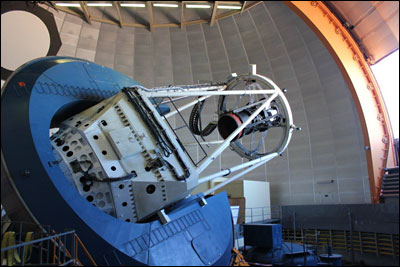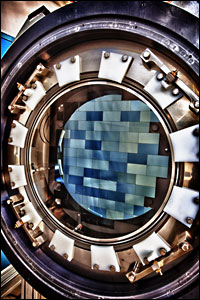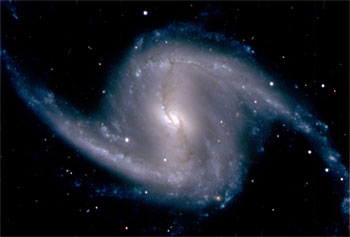
Dark Energy Camera Records First Images
After eight years of planning and construction, the most powerful sky-mapping machine ever created, the 570-megapixel Dark Energy Camera (DECam), achieved first light on Sept. 12.
The camera was constructed at Fermi National Accelerator Laboratory in Batavia, Ill., and mounted on the Victor M. Blanco telescope at the National Science Foundation's Cerro Tololo Inter-American Observatory (CTIO), the southern branch of the US National Optical Astronomy Observatory (NOAO). With this device, roughly the size of a phone booth, astronomers and physicists will probe the mystery of dark energy, the force they believe is causing the universe to expand faster and faster.

The Dark Energy Camera mounted on the Blanco telescope in Chile. (Photo: Dark Energy Survey Collaboration)
A photometric imaging camera, it measures the amount of light in various colors from astronomical objects rather than details of their spectra. It can see light from more than 100,000 galaxies up to 8 billion light-years away in each snapshot.
Scientists in the Dark Energy Survey collaboration will use the camera, with its array of 62 CCDs with unprecedented sensitivity to red light, to undertake the largest galaxy survey ever. They will use the data to carry out four probes of dark energy, studying galaxy clusters, supernovae, the large-scale clumping of galaxies and weak gravitational lensing. This will be the first time all four of these methods will be possible in a single experiment.
“The Dark Energy Survey will help us understand why the expansion of the universe is accelerating, rather than slowing, due to gravity,” said Brenna Flaugher, project manager and scientist at Fermilab. “It is extremely satisfying to see the efforts of all the people involved in this project finally come together.”

The Dark Energy Camera features 62 charged-coupled devices (CCDs), which record a total of 570 megapixels per snapshot. (Photo: Fermilab)
Fermilab turned to Lawrence Berkeley National Lab for the CCDs needed, realizing that the high-redshift galaxies they sought would require longer exposures to get secure photometric results. Berkley Lab's CCDs have higher quantum efficiency in the near-infrared than typical astronomical CCDs.
Manufacture of the DECam CCDs was overseen by Steve Holland, a senior engineer in Berkeley Lab’s Engineering Div. who invented the Berkeley Lab CCD in the mid-1990s as a spinoff from research and development of detectors for high-energy physics.
“Fermilab was attracted to our CCDs because of their improved red response,” Holland said, “but considering that there were as yet no big cameras using them when DECam was planned, they had to decide to take a risk.”
The DECam chips were fabricated by Berkeley Lab’s industrial partner, Teledyne Dalsa Semiconductor, and the Physics Div.’s MicroSystems Laboratory. Partially finished wafers holding four CCDs, each with eight of 11 masking steps completed, were commercially thinned, then sent to the MicroSystems Laboratory for completion. “Cold probe” tests at -45 °C were performed to detect shorts, defects and excessive dark current. The CCDs were cut from the wafer and sent to Fermilab for mounting and final testing of the science-grade devices.

Zoomed-in image from the Dark Energy Camera of the barred spiral galaxy NGC 1365, in the Fornax cluster of galaxies, which lies about 60 million light-years from Earth. (Image: Dark Energy Survey Collaboration)
The survey is expected to begin in December, after the camera is fully tested, and will take advantage of the excellent atmospheric conditions in the Chilean Andes to deliver pictures with the sharpest resolution seen in such a wide-field astronomy survey. In just its first few nights of testing, the camera has delivered images with excellent and nearly uniform spatial resolution, astronomers say.
Over five years, the survey will create detailed color images of one-eighth of the sky, or 5000 square degrees, to discover and measure 300 million galaxies, 100,000 galaxy clusters and 4000 supernovae.
The Dark Energy Survey is supported by funding from the US Department of Energy and the National Science Foundation, from funding agencies in the UK, Spain, Brazil, Germany and Switzerland, and from participating Dark Energy Survey institutions.
For more information, visit: www.darkenergysurvey.org
Published: September 2012